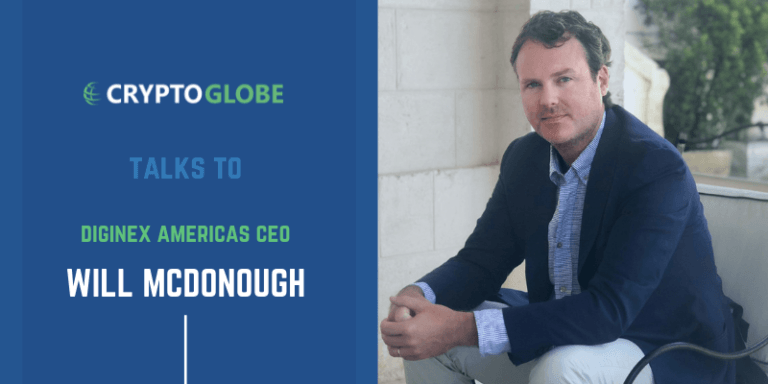
Will McDonough has one of the most interesting backgrounds in the crypto space.
Running a management company which represented New England Patriots Quarterback Tom Brady, supermodel Gisele Bundchen and the estate of Nelson Mandela, he went on to the Investment Management Division of Goldman Sachs before launching Atlas Mara, a company that acquired banks in Africa which he took public on the London Stock Exchange in 2014.
Moving into the crypto and blockchain industry in 2017 with the launch of iCash, the first ever smart contract adjudication protocol for blockchain transactions, Will is now Chairman and CEO of Diginex Americas, a digital asset investment bank.
I spoke to Will about his background before crypto, why he got into the space, what will bring the institutions to crypto, and what’s in store for Diginex in 2019 and beyond.
You’ve managed Tom Brady, worked for Goldman Sachs, and bought banks in Africa, is there a unique thread that runs through your career?
Luck.
Luck is when preparation meets opportunity and I’ve been very lucky throughout my career to work with interesting partners in interesting businesses. Each business I’ve had has been a product of my experiences and the ability to prepare for and pounce on an opportunity. Opportunities don’t last long and when you see them you need to execute fast. When I was in high school I actually started my professional career with the New England Patriots. While working in the organization’s marketing group, I was tasked with bridging the gap between our players, our community and sponsors. Being able to do this for the team exposed me to Tom Brady and gave me relationships that still benefit me today. Those experiences drove me to form my own management company, and that business continues today, managing the Estate of Nelson Mandela and building partnerships for many notable athletes and entertainers, including Tom Brady, and his wife Gisele Bundchen.
While running MMG I came into contact with many incredible people in the world of finance, one of whom was the founder of Avenue Capital, Marc Lasry. At our first meeting we started to discuss building a fund of funds to leverage our collective access. Within a year we set up a distressed debt and credit fund-of-funds, and I moved to NY to build it out. That was a once in a lifetime opportunity, I was prepared for it, and I pounced.
When I was in NY, I became close with Gary Cohn, the former President and COO of Goldman Sachs, who recruited me to the firm to manage the Partners’ Capital. It was Goldman where I learned first hand the importance of diversifying across the alternative investment space and how hard it is for many to get appropriate exposures to esoteric asset classes or geographies. I further took an interest in the emerging markets of Africa and brought a business to Bob Diamond (former CEO of Barclays) and he and I co-founded Atlas Mara, a network of banks in Africa which we took public on the London Stock Exchange in 2014. After taking Atlas Mara (ATMA: LSE) public, I focused all of my attention on Financial Technologies, and dove in deep to blockchain, which brought me to Diginex with the sole intent of creating a regulation focused, compliant digital asset and blockchain company built on the rigors of the professional financial services world I come from, to deliver institutional grade offerings in this new world of business and finance.
When did you first hear about Bitcoin, and why did you decide you wanted to be involved in the crypto ecosystem?
I first heard about Bitcoin after my attempt to buy MoneyGram International, the global payments company. One of the biggest threats to MoneyGram is the bitcoin protocol. That was when I fell down the proverbial “crypto rabbit hole” and quickly realized that digital assets have huge potential. Coming from traditional financial services, I saw first hand the many inefficiencies that blockchain technology and digital assets can solve. One of my first realizations is that to realize those efficiencies the proper infrastructure must be set up and I dove right in.
What led you to Diginex Americas and what makes it unique?
Diginex has a uniquely strong team of high-caliber financial services and technology professionals. The caliber and experience of this team is without rival. This, along with the global reach and clear vision, is what drew me to the firm. The opportunity to build out the American infrastructure as CEO of Diginex Americas allows me to contribute directly to the growth of the firm both on home soil and abroad. The adoption of blockchain and digital assets on the institutional level will take place slowly and with experienced professionals on both sides of the table working together to tap into the benefits. Diginex Americas is uniquely positioned to do that.
What do you say to Bitcoin maximalists who believe only in bitcoin and view blockchain outside of Bitcoin as an unnecessary solution?
Bitcoin is an amazing innovation and does exactly what it was designed to do. That is P2P decentralized and censorship-resistant transactions. Blockchain technology is revolutionizing the way data is secured and transferred. To state that the only way this technology should be levered is short sighted. Blockchain can bring the efficiencies it brings to Bitcoin value transfers to lots of data transfer parallels and can drive massive efficiencies to legacy systems.
How do you convince skeptics that crypto-assets and blockchain are worth getting excited about?
The volatility and growth of the value of Bitcoin and other digital assets over the last 2 years has brought a lot of attention to our technology and the associated currencies. Many of these currencies are a direct correlation to the demand for and adoption of their associated blockchains, and are a great way for investors of all sizes to get exposure to that growth. Usually when new technologies are implemented and adopted retail investors don’t hear about them or have access to invest in them until they’re much more mature. This is a gift and a curse because the earlier you invest the more volatile hypothetically the opportunity. This also can provide participation to massive appreciation if you’re invested in whoever becomes the next platform for accessing blockchain technology. People investing in crypto assets associated with early technologies need to be aware of and prepared for risk and volatility, and understand this is not like investing in traditionally more mature public companies.
Do you think the frenetic bull run of 2017 and subsequent crash was a net positive or a net negative for the industry?
Definitely a net positive. It brought a lot of attention to a space that previously had little to no attention. 2017 also marked the exodus of smart and successful people leaving high-paying and comfortable jobs to jump headfirst into blockchain. This influx of high quality human capital has only led to more implementation of the technology and has been driving innovation ever since that run. The institutional adoption of the technology and recognition of the asset class sped up adoption massively and is a great benefit to the community.
Do you think “the institutions are coming”? If so, what will be the key driving factor that will bring them to the space?
They definitely are.
Many of them are already here, and have invested in blockchain-specific funds or in Bitcoin directly to gain exposure. I believe the days of institutions holding digital assets in their portfolios is coming soon as well, but that will take a maturation of their mandates to allow for this newly defined asset, so availing them of products they can hold, that expose them to those assets, will be a major opportunity. Only helping that will be clear regulation from the SEC and CFTC and the digital asset custody infrastructure being developed to a point where there is virtually no risk of the assets being stolen, or at least those assets being insurable.
What is on the Diginex Americas roadmap for the year?
The goal is to establish a compliant footprint throughout the world that will allow us to transact and benefit businesses. We are still early in the blockchain story and thus have the time and patience to do it right. This will ensure we will be a big part of the story of blockchain and it’s future. By approaching this opportunity in an institutional manner we are able to work with the world’s top companies and operate at an extremely high level.








